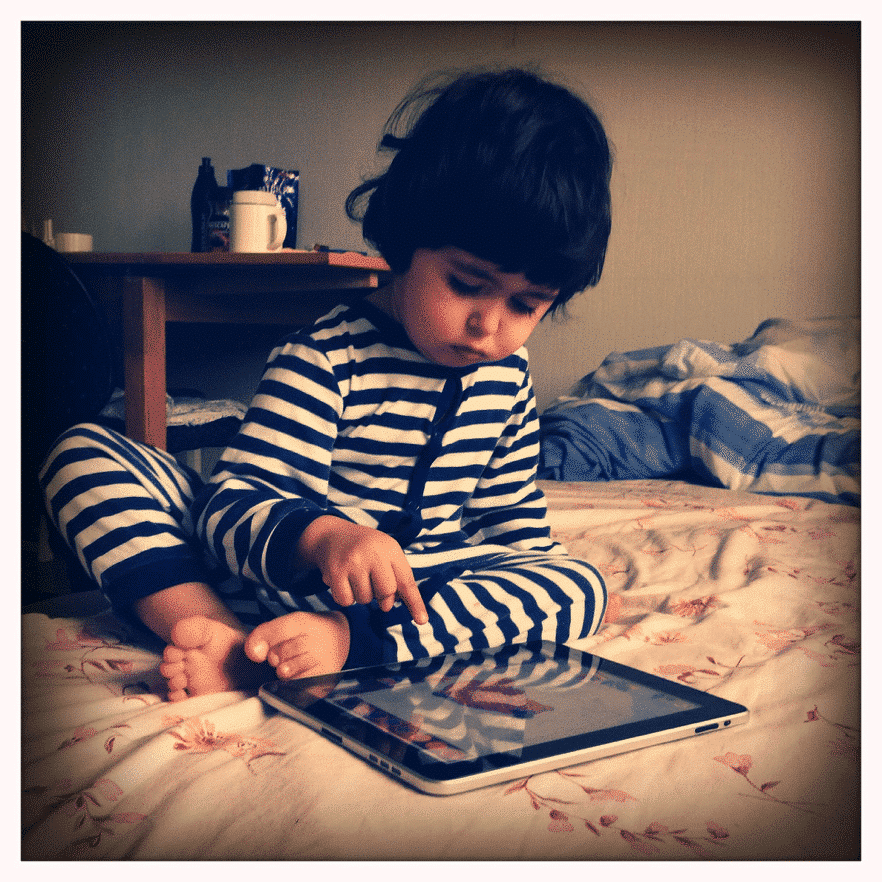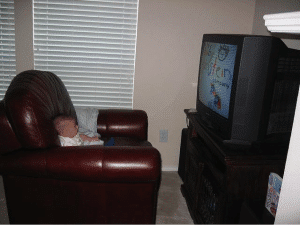
When my CSUCI intern, Alanna Dantona, expressed her interest in researching and writing about the history of educational software for infants and toddlers I was thrilled. As a mother of a 22 year-old, I was one of the parents who plunked her infant down in front of Baby Einstein videos in the 1990s, with the hopes of stimulating intellect and creativity. Fast-forward to the software available to infants and toddlers today and one sees a fascinating trajectory in hope and profit, indeed. Read part one of this three-part series to learn about what Alanna uncovered about screen content intended to help infants and toddlers learn. Not only will it help you with the teeny ones in your life, but this article is also a fascinating tale of hope, entrepreneurship, and brain development among we hopeful, screen-addicted cyborgs.
Technology on the Rise
Tech innovators are constantly creating new screen activities to make our lives better and easier. With immediate information access at our fingertips, we are getting increasingly dependent on our screens for outsourcing tasks, including childcare and academic tutoring. Parents spend BIG money for educational and entertainment screen content ever since the first “intellectual development videos for baby” were introduced by the Baby Einstein Company in the late 1990s. Despite a scarcity of research demonstrating benefit, the child toy and software market continue to flood the market with more products each year, increasingly targeting infants and toddlers as consumers. How did this get started and what do we know today?
The Beginning of Baby Einstein
Julie Aigner-Clark, founder of the Baby Einstein Company, developed the idea for the multimedia brand after leaving her teaching career to become a stay-at-home mom. As a mom of an infant daughter, she became discouraged by the lack of media available to expose children to music, poetry, and art. Determined to introduce her daughter to the subjects she once taught in her own classroom, Mrs. Clark created a personalized educational video using borrowed film equipment, toys, classical music, and computer editing software.
After spending approximately a year and $15,000 creating the first Baby Einstein video, Clark started to market her new invention aimed at enriching baby’s intellectual and emotional experience. She sent her first tape to a catalog company, but received no response. She hung in there though, and by a stroke of luck later met a buyer from that same catalog at a trade show. The company loved her work so much they ordered over 100 copies and sold every one. Baby Einstein was launched. In the first five years in business, Clark earned a profit of $22 million for her video sales (Garrard, 2009).
Through her desire to educate her infant daughter, Clark unknowingly sparked a video revolution in the field of early childhood education. In an effort to compliment the explosive brain development that infants and toddlers undergo in their first three years of life, she sought to enrich their language and literacy skills and promote creativity through use of colorful, moving art materials in synch with classical music. Catchy and clever characters such as “Vincent Van Goat” and “Bach the Rabbit” were created to be particularly attractive and marketable to young children and their parents. By offering videos with content not typically taught through traditional instruction, she was able to establish a wildly popular brand that still has name recognition today (Thomas, 2007).

The Disney Deal
Julie Aigner-Clark was not only a great inventor, but she also had a head for good marketing. Along with selling the public on the Baby Einstein brand, she also sold them on her personal brand as an entrepreneuring mom. In a stroke of genius, she personalized her products by including a segment at the end of each video, where she introduced herself as a hard-working middle class mom who believed fully in her mission to enrich the intellectual lives of babies and toddlers. Moms all over the world felt a kinship with Julie, wanting their babies to benefit from her vision and sharing and supporting her venture as well. When the Disney Company considered the purchase of her company in 2001, they learned through focus groups that there was little need for further advertising, because word of mouth from mother-to-mother was enough to substantially increase sales (Thomas, 2007).
In 2001, Julie Aigner-Clark and her husband sold the Baby Einstein Company to the Walt Disney Company for $25 million dollars. It would seem that if a multi-billion dollar company took over, the program must have some educational promise. Right?

Did Baby Einstein Videos Enrich Baby’s Learning?
Despite the appeal and wild success of Baby Einstein, the research failed to demonstrate that Baby Einstein videos did what was promised to consumers. As a result, the Campaign for a Commercial Free Childhood (CCFC) pressured the company into providing a $15.99 refund to anyone who purchased a Baby Einstein video between June 5, 2004 and September 4, 2009. Furthermore, the Baby Einstein website agreed to no longer offers DVDs or videos. Due to ethical labeling requirements, they can also no longer label their videos as “educational.” It appears that the Baby Einstein generations did not produce Einsteins after all . . . but what about today’s screen products?

I’m the mom psychologist who will help you GetYourKidsInternetSafe.
Onward to More Awesome Parenting,
Tracy S. Bennett, Ph.D.
Mom, Clinical Psychologist, CSUCI Adjunct Faculty
GetKidsInternetSafe.com
Works Cited
Baby Einstein Recall: Refunds Offered on Educational DVDs. (2009, October 26). Retrieved from http://study.com/articles/Baby_Einstein_Recall_Refunds_Offered_on_Educational_DVDs.html
Garrard, C. (2009). Big Idea: Meet the Creator of Baby Einstein. Retrieved from http://www.parents.com/baby/development/intellectual/baby-einstein-creator/
Thomas, S. G. (2007). Buy, buy baby: How consumer culture manipulates parents and harms young minds. Boston: Houghton Mifflin.
Photo Credits
Untitled By Venturist, BY CC 2.0
Mason Watching Baby Einstein by .imelda, BY CC 2.0
Baby Einstein by Pablo Orezzoli, BY CC 2.0
Don't worry, we will never spam you.









